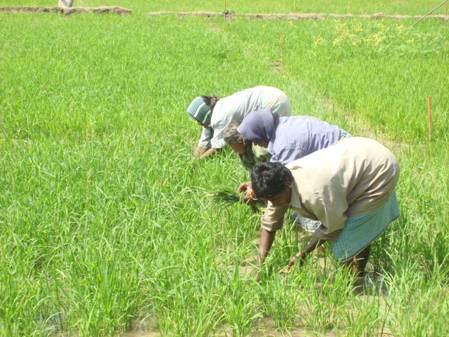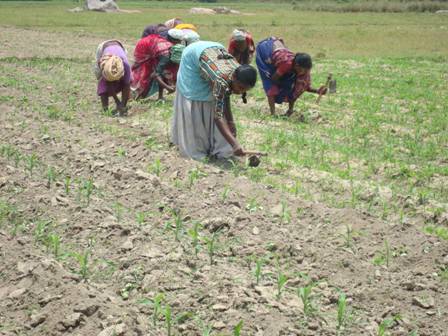|
PHYSICAL METHODS OF WEED CONTROL
Physical force either manual, animal or mechanical power is used to pull out or kill weeds. Depending on weed and crop situation one or combination of these methods are used.
Hand-weeding
- Pulling out weeds by hand or uprooting weeds by using small hand tool is known as hand weeding.
- Two aspects are important in hand weeding: the number of hand weedings to be done and the interval between two hand weedings.
- The number of hand weedings to be done depends on crop growth, weed growth and critical period of crop-weed competition.
- The number of hand weedings range from 2-4 for most of the field crops.
- The interval between two weedings depends on the quickness of weed growth which interferes with crop growth. Generally, it is 15-20days.

Hand hoeing
- The entire surface soil is dug to a shallow depth with the help of hand hoes, weeds are uprooted and removed.
- After hand hoeing, the field is subjected to drying to avoid re-establishing of uprooted weeds.
- This method is adopted in irrigated upland crops like finger millet, pearl millet, onion etc.
Digging
- Weeds are removed by digging up to deeper layers so as to remove underground storage organs.
- It is very useful in the case of perennial weeds and it is donewith the help of pick axes or crowbars. Cynodon dactylon can be effectively controlled by this method.
Mowing
- Mowing is the cutting of weeds to the ground level.
- Mowing is usually practiced in non-cropped areas, lawns and gardens wherein the grass is cut to a uniform height to improve the aesthetic value.
- The common mowing tools are sickle, scythe and lawn mower.
Cutting
- Weeds are cut above the ground surface leaving stubble. It is most common practice against brush and trees.
- Cutting is done with the help of axes and saws.
Dredging and Chaining
- Dredging and chaining methods are used to control aquatic weeds.
- Removing of weeds along with their roots and rhizomes with the help of mechanical force is called dredging.
- The floating aquatic weeds are removed by chaining.
- A very heavy chain is pulled over the water bodies to collect the weeds.
Burning and Flaming
- Burning is the cheapest method of eliminating mature unwanted vegetation from uncropped areas like range lands, field bunds, roadsides, ditch banks etc.
- It is also used to dispose off heaped weeds. However, it is a 'potential source of fire hazard.
Mulches
- Mulches when applied on soil surface, do not allow weeds to germinate or to grow as light does not reach the soil.
Intercultivation
-
Intercultivation is a very effective and cheap method of weed control in line-sown crops. Intercultivation implements have a blade which cuts the weeds just below the soil surface and thus kills weeds. It also makes the surface soil loose and dry so that subsequent germination of weeds is avoided unless irrigation or rain follows.
-
Some of the intercultivation implements have tynes, which open the soil and uproot the weeds.
|




